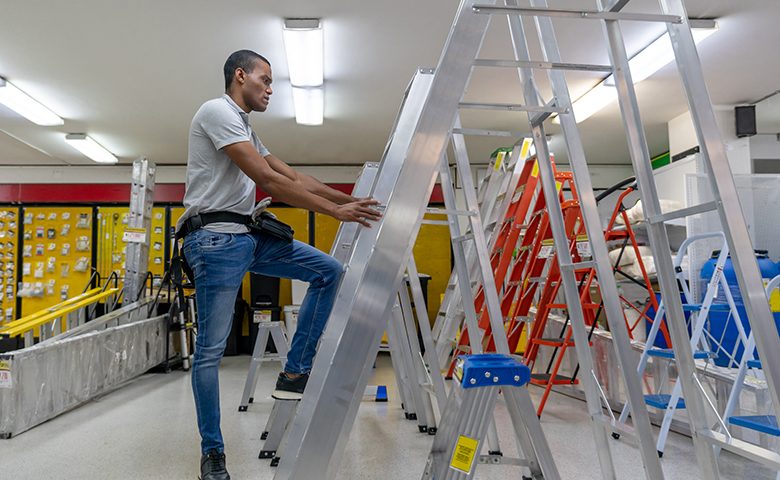When selecting a portable ladder, one of the most common errors people make is choosing the wrong ladder for the task they’re performing. It’s easy to just use the ladder that’s on hand without considering whether it’s appropriate for the task. The physical environment is the most overlooked driver of bad habits and complacency has a way of changing your perception of risk to make you think it’s ok to grab any ladder for any job.
Each year, there are more than 164,000 emergency room-treated injuries and 300 deaths in the U.S. caused by falls from ladders. So it should not come as a shock that ladders have been on the OSHA top ten violations list for the past 12 years, moving up to the number 3 spot in 2021. The citations are issued because ladders are not being used for their intended purpose, employees are using the top step of ladders, ladders are used on unstable/unlevel ground, or workers ascend ladders while carrying large loads.
Here are some quick tips to ensure workers are using the correct ladder.
Material
Aluminum ladders are often a popular choice because they are lightweight and easy to carry (not to mention inexpensive). But everyone knows that metal and electricity don’t mix—so when working near sources of electricity, it’s vital to avoid aluminum ladders. For the same reason, it’s important to ensure wooden ladders do not have metal reinforcement wires that can conduct electricity. Two benefits of wooden ladders are that wood is not a conductor of electricity and wood does not become hot or cold in ambient temperatures. Fiberglass is a great choice for a long-lasting ladder as it does not conduct electricity or retain outdoor temperatures the way aluminum does.
Safety tip: Inspect ladders before each use. Ladders could have fallen or been dropped between use, which can affect the condition of the ladder.
Here’s a quick, non-exhaustive checklist to help workers inspect ladders before use; if they notice any damage, the ladder should be tagged and removed from service:
□ Ensure the non-slip feet aren’t damaged or worn.
□ Check that there aren’t any loose screws, nails, bolts or nuts.
□ Look at the spreaders and locks to make sure they aren’t worn, loose or faulty.
□ Try to move the rungs/steps to see if they are loose and ensure none are missing.
□ Check the overall condition—look for warping, rot or decay in wooden ladders, cracks in fiberglass, corrosion, rust or excessive wear on treads.
Weight
Another issue to consider when making a ladder selection is the ladder rating. This will determine the maximum weight capacity of the ladder including the worker’s weight and the weight of any PPE, tools or supplies being carried or used on the ladder.
The American National Standards Institute (ANSI) has five ladder grade categories.
Type l (Heavy Duty) — most commonly used in a professional/industrial setting. Regardless of the material, these ladders come in lengths from three to 20 feet and are built to manage loads of up to 250 lbs. Werner’s color code for fiberglass and aluminum is blue.
Type IA (Extra Heavy Duty) — a subcategory of Type I, this grade can hold up to 300 lbs. Werner’s color code for fiberglass and aluminum is orange (aluminum could also be black).
Type IAA (Extra Heavy Duty) — a subcategory of Type I, this grade can hold up to 375 lbs. Werner’s color code for fiberglass and aluminum is yellow.
Type II (Medium Duty) — also run in lengths of three to 20 feet long. These ladders are suited to commercial use by workers such as painters, electricians, or maintenance staff. They have a weight maximum of 225 lbs. Werner’s color code for fiberglass and aluminum is green.
Type III (Light Duty) — most commonly used as household ladders. They only handle a load capacity of 200 lbs and come in lengths between three and six feet. Werner’s color code for fiberglass and aluminum is red.
Not all ladders are color-coded, but some people refer to the color rating to quickly determine which ladder they need.
Safety tip: Use the 4 to 1 rule when determining how much distance the base of the ladder needs before setting it up. The 4 to 1 rule dictates for every four feet you have to climb, move the ladder out one foot. This will maximize stability to ensure the ladder can support your weight and the weight of any tools/supplies/PPE.
Size
Regardless of the task, you will want a ladder longer than you need to reach. According to Werner, the “maximum safe reaching height is approximately 4′ higher than the height of the ladder” e.g., an average person can reach an 8′ ceiling on a 4′ ladder safely. Check out their website for handy step ladder and extension ladder reach guides and approximate material weights chart.
Safety tip: Never stand above the third rung from the top on a step ladder or the fourth rung from the top on an extension ladder.
If you need a few more safety tips for working with ladders, check out these safety guidelines. Just because ladders are something you can find around the house does not mean they’re universal in purpose. Make sure your workers know enough about ladders before using them. And remember that an essential part of ladder safety is the ability to monitor and mitigate human factors like fatigue that can lead to using a ladder unsafely.

